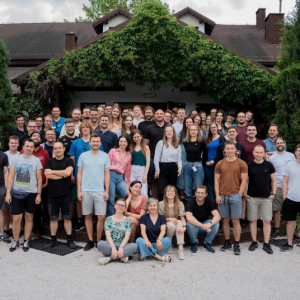In August 2020, we received the first applications for a unique job offer that we recently published. The job offer was addressed to a development team, not to a single developer. Where did this decision come from? It was really just a matter of time as our company needed a well-coordinated team, ready to act. However, the benefits were mutual.
“We were aiming to gain a team that knows its strengths and weaknesses, has established rules, and does not have to learn how to work as a team. On the other hand, the team gains the opportunity to work in a squad that they like and know what to expect from each other” says Marcelina Szostak-Kustra, HR Manager at Clearcode. How did this recruitment process look on the inside? Read on!
Let us guide the reader through the entire process from the idea to the recruitment of the development team. First of all, tell me how the recruiting process for a developer usually looks at Clearcode?
A typical Clearcode recruitment process is quite quick, but also comprehensive. It usually consists of two, but a maximum of three, stages of recruitment. What these stages will be depends mainly on the team’s preferences. Most often, it involves a telephone-screening stage, a standard recruitment interview, and a practical or pair programming task. This applies primarily to technical recruitment processes at Clearcode.
And before the job is advertised? What happens before you start searching for candidates?
At the beginning, the team manager provides the HR team with either a specific idea of the candidate the team is looking for or just some brief information that she or he wants to expand the team.
In the first case, the team fills in a Google Docs (the document stating the need for recruitment), which includes the most important information regarding the ideal candidate’s competences, location, remote work opportunities and the proposed shape of the recruitment process.
Then, the HR representative (seeing as there are two of us in the team, it’s either me or Kasia) organizes a meeting with the people involved in the recruitment process. We complete the missing information together and create a profile, job advertisement and action points that our team will take to recruit a new person to the team.
In the meantime, we also conduct some market research. People from inside our organization as well as candidates from outside of Clearcode can participate in the recruitment process.
In the second case, we organize workshops with the team, during which we define what competencies are needed in the team and which of them we want to satisfy with recruitment. From there, the recruitment process is similar to the first case.
How many people have you employed over the years?
At the moment, more than 90 people are working at Clearcode. Until recently, we operated as two companies — Clearcode as a software house and Piwik PRO as a product company. We had about 180 people across both companies, but this year we officially split our businesses and selected a new management board. When I joined the company in December 2015, we were a company of around 100 people. A lot has changed since then, and in retrospect, we’ve grown a lot.
Where did the idea to recruit an entire development team come from? What was the reason and the idea behind this?
The idea to start the process to recruit an entire team emerged during a meeting between the HR team and the new management team. We talked about Clearcode’s business strategy and company’s growth plans, and exchanged ideas about what we can do to reach more candidates on the market.
This all happened during the pandemic, so while we were observing layoffs in the market, we thought that maybe there are some IT companies that are being forced to cut jobs and can avoid it by delegating their team to us. In short, we were initially interested in the acquisition of a whole team.
So we reached out to some software houses that we knew, but this strategy did not work out. It turned out that the IT industry was doing quite well in the face of the pandemic and everyone needed all hands on deck.
We decided to create a simple recruitment offer addressed to a few (2-5) people who worked in one team, were looking for a job (we did not contact passive candidates, we were only interested in active ones), and did not want to be separated from their teammates.
That way, we’d get a team that knows its strengths and weaknesses well, has established rules of the game, and does not have to learn how to work as a team. They, on the other hand, would have the opportunity to work in a composition they like and know what to expect from each other.
Why didn’t you decide to recruit the required developers separately?
In this particular situation, we assumed that it would be easier to onboard a team that has already worked together than to put people from different backgrounds in one bag and build a team from scratch. Additionally, the recruitment of experienced IT people at Clearcode takes a long time, so we didn’t want to make the recruitment process any longer than it had to be.
There is also the possibility of employing the entire team on the market through outsourcing. Wouldn’t that be a simpler, more secure solution?
We do not rule out those kinds of options and for some time we have been cooperating with outsourcing companies, but so far it’s been individuals rather than a whole team. However, due to the fact that as a company we want to grow in the near future and list on the stock exchange within 5 years, we primarily want to build teams that are part of Clearcode for a long time, consistent with our culture and style of work. Cooperation under outsourcing or body leasing is actually safer, but also carries various risks.
What are the advantages and disadvantages of recruiting an entire team ?
Time is definitely an advantage and a disadvantage. If we’re successful in recruiting a whole team, then we’ve optimized our time. If we’re unsuccessful, then we’ve lost a lot of valuable time. However, it is a kind of investment.
I also see the advantage of being able to explore the dynamics of the collaboration of the entire team. In the case of such recruitment, the possible shortcomings of individual people are not as important as the entire system, in which a less experienced person in a given area can benefit from the more experienced people, and the mere lack of any competence in one person does not exclude the employment of a team.
When it comes to disadvantages, the simultaneous recruitment of several people is a logistical challenge, a potential risk in the form of consulting individual people from the team during recruitment, as well as the risk that these people will not fit into our organization’s culture as a team. There’s also the risk that they will all leave as a team after some time.
How did the recruitment process go? Did you receive many applications from teams and did many individuals apply?
We had both types of situations. There were people who did not understand our job advertisement and applied as individuals. However, there were also applications from several people who worked together on several projects and we invited them as a team to take part in our recruitment process.
Despite recruiting a whole team, did you talk to each person separately?
We decided that we would like to check the competences of individual people, because ultimately we will employ them individually, not only as a team. We started with recruitment interviews, during which I led the so-called soft part, and an experienced technical leader from our team was responsible for the technical part. After successfully completing this stage, all team members were given a recruitment assignment to be carried out at home.
In the meantime, it turned out that the team members wanted to work with a more experienced team. Luckily for us, one of our existing teams expressed a desire to recruit several people, so the idea came up to add our new recruits to the existing team in Clearcode. As the last step, we organized an online meeting with the recruited development team and members of the team they would join. This gave both sides the opportunity to learn about each other’s dynamics and, thankfully, it turned out that there was chemistry between everyone.
What do you do when one of the members of the recruited team leaves or there is a need to expand the team?
The risk of the departure of one or the whole group of people is something that we were aware of when deciding on the idea of recruiting an entire team. We focus on open communication and we will examine the mood and perceptions about the cooperation of the new people, both on the part of the manager and on the part of the HR team. If there is a need to expand the team, we will certainly talk about it with the interested parties themselves. At Clearcode, we pay a lot of attention to two areas: business and people. We do not look at our people as entries in Excel cells, but we try really hard to make everyone work well. It sounds like a cliche, but if it were not true, I would not have worked in our HR team for so long. In fact, I probably wouldn’t have even got a job here.
Was there a team leader in the recruited team? What role did he get by joining the Clearcode team?
No, there was no team leader in the recruited team. If a team with a manager came to us, we would probably approach the recruitment similarly, but devote a lot of attention and time to checking the manager’s suitability to the culture of our organization and the way we work.
Did each of the recruits have different or the same requirements as offered by Clearcode? I am asking not only about salaries, but also about the need for support in development.
In part, the requirements were consistent, but we looked at them both from an individual and a team perspective. People who joined us are at a similar stage of development, hence some of their requirements were similar. I think that once they start working with us, I hope I’ll be able to provide more details about this.
Does your plan match reality? Was the team finally split up, was it assigned specific projects, or did it join another team?
The condition that we set for ourselves at the beginning of the recruitment process was that we do not want to separate the team. We considered building a separate team with new people, joining them temporarily to another team as part of the onboarding process, or joining another team permanently. Eventually, they joined an existing development team that is in the process of implementing a large project.
Are you still looking for teams and not individual developers?
We definitely want to continue the topic of recruiting teams. It doesn’t have to be a group of 10 people. In fact, a team can be made up of just 2 to 3 people. Despite the risks, we see it as an opportunity to build or expand existing teams in Clearcode. However, we do not want to take entire teams from other companies ourselves; we’re rather looking for people who are already active on the labor market and are searching for new development opportunities themselves. We’re also interested in working with other companies that may be in a more difficult situation on the market. In such a case, we’d be interested in taking over another team. Of course, in both versions, we expect there to be a match in terms of technology and culture.











